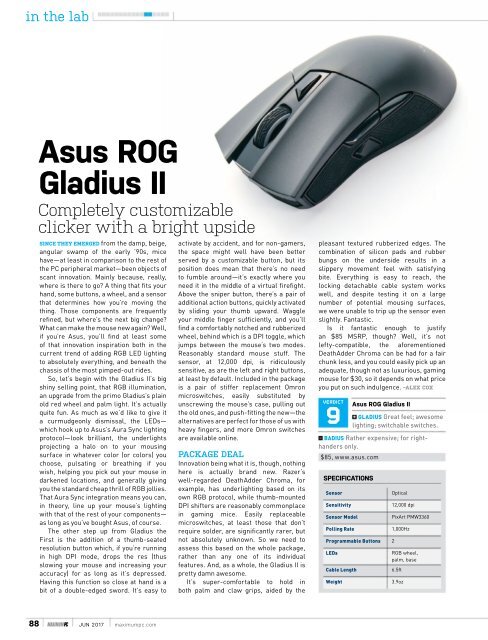Maximum_PC_June_2017
Create successful ePaper yourself
Turn your PDF publications into a flip-book with our unique Google optimized e-Paper software.
in the lab<br />
Asus ROG<br />
Gladius II<br />
Completely customizable<br />
clicker with a bright upside<br />
Since they emerged from the damp, beige,<br />
angular swamp of the early ’90s, mice<br />
have—at least in comparison to the rest of<br />
the <strong>PC</strong> peripheral market—been objects of<br />
scant innovation. Mainly because, really,<br />
where is there to go? A thing that fits your<br />
hand, some buttons, a wheel, and a sensor<br />
that determines how you’re moving the<br />
thing. Those components are frequently<br />
refined, but where’s the next big change?<br />
What can make the mouse new again? Well,<br />
if you’re Asus, you’ll find at least some<br />
of that innovation inspiration both in the<br />
current trend of adding RGB LED lighting<br />
to absolutely everything, and beneath the<br />
chassis of the most pimped-out rides.<br />
So, let’s begin with the Gladius II’s big<br />
shiny selling point, that RGB illumination,<br />
an upgrade from the primo Gladius’s plain<br />
old red wheel and palm light. It’s actually<br />
quite fun. As much as we’d like to give it<br />
a curmudgeonly dismissal, the LEDs—<br />
which hook up to Asus’s Aura Sync lighting<br />
protocol—look brilliant, the underlights<br />
projecting a halo on to your mousing<br />
surface in whatever color (or colors) you<br />
choose, pulsating or breathing if you<br />
wish, helping you pick out your mouse in<br />
darkened locations, and generally giving<br />
you the standard cheap thrill of RGB jollies.<br />
That Aura Sync integration means you can,<br />
in theory, line up your mouse’s lighting<br />
with that of the rest of your components—<br />
as long as you’ve bought Asus, of course.<br />
The other step up from Gladius the<br />
First is the addition of a thumb-seated<br />
resolution button which, if you’re running<br />
in high DPI mode, drops the res (thus<br />
slowing your mouse and increasing your<br />
accuracy) for as long as it’s depressed.<br />
Having this function so close at hand is a<br />
bit of a double-edged sword. It’s easy to<br />
activate by accident, and for non-gamers,<br />
the space might well have been better<br />
served by a customizable button, but its<br />
position does mean that there’s no need<br />
to fumble around—it’s exactly where you<br />
need it in the middle of a virtual firefight.<br />
Above the sniper button, there’s a pair of<br />
additional action buttons, quickly activated<br />
by sliding your thumb upward. Waggle<br />
your middle finger sufficiently, and you’ll<br />
find a comfortably notched and rubberized<br />
wheel, behind which is a DPI toggle, which<br />
jumps between the mouse’s two modes.<br />
Reasonably standard mouse stuff. The<br />
sensor, at 12,000 dpi, is ridiculously<br />
sensitive, as are the left and right buttons,<br />
at least by default. Included in the package<br />
is a pair of stiffer replacement Omron<br />
microswitches, easily substituted by<br />
unscrewing the mouse’s case, pulling out<br />
the old ones, and push-fitting the new—the<br />
alternatives are perfect for those of us with<br />
heavy fingers, and more Omron switches<br />
are available online.<br />
Package deal<br />
Innovation being what it is, though, nothing<br />
here is actually brand new. Razer’s<br />
well-regarded DeathAdder Chroma, for<br />
example, has underlighting based on its<br />
own RGB protocol, while thumb-mounted<br />
DPI shifters are reasonably commonplace<br />
in gaming mice. Easily replaceable<br />
microswitches, at least those that don’t<br />
require solder, are significantly rarer, but<br />
not absolutely unknown. So we need to<br />
assess this based on the whole package,<br />
rather than any one of its individual<br />
features. And, as a whole, the Gladius II is<br />
pretty damn awesome.<br />
It’s super-comfortable to hold in<br />
both palm and claw grips, aided by the<br />
pleasant textured rubberized edges. The<br />
combination of silicon pads and rubber<br />
bungs on the underside results in a<br />
slippery movement feel with satisfying<br />
bite. Everything is easy to reach, the<br />
locking detachable cable system works<br />
well, and despite testing it on a large<br />
number of potential mousing surfaces,<br />
we were unable to trip up the sensor even<br />
slightly. Fantastic.<br />
Is it fantastic enough to justify<br />
an $85 MSRP, though? Well, it’s not<br />
lefty-compatible, the aforementioned<br />
DeathAdder Chroma can be had for a fair<br />
chunk less, and you could easily pick up an<br />
adequate, though not as luxurious, gaming<br />
mouse for $30, so it depends on what price<br />
you put on such indulgence. –Alex cox<br />
verdict<br />
9<br />
Asus ROG Gladius II<br />
Gladius Great feel; awesome<br />
lighting; switchable switches.<br />
Badius Rather expensive; for righthanders<br />
only.<br />
$85, www.asus.com<br />
SPECIFICATIONS<br />
sensor<br />
sensitivity<br />
sensor Model<br />
Polling Rate<br />
Programmable Buttons 2<br />
lEds<br />
Cable length<br />
Weight<br />
Optical<br />
12,000 dpi<br />
PixArt PMW3360<br />
1,000Hz<br />
RGB wheel,<br />
palm, base<br />
6.5ft<br />
3.9oz<br />
88 MAXIMUM<strong>PC</strong> jun <strong>2017</strong> maximumpc.com


















